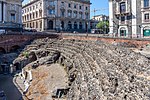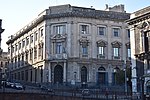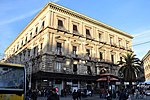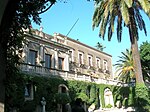Palazzo Tezzano
1827 establishments in ItalyBuildings and structures completed in 1727Buildings and structures completed in 1827Hospital buildings completed in the 18th centuryPalaces in Catania

The Palazzo Tezzano is a monumental palace in Piazza Stesicoro, in the center of Catania, Sicily, southern Italy. The via Etnea, with prominent shops, bisects the Piazza; this palazzo rises at the northwest intersection with this via, across from the white stone, neoclassical Palazzo Paterno del Toscano.
Excerpt from the Wikipedia article Palazzo Tezzano (License: CC BY-SA 3.0, Authors, Images).Palazzo Tezzano
Via Etnea, Catania Centro storico
Geographical coordinates (GPS) Address External links Nearby Places Show on map
Geographical coordinates (GPS)
| Latitude | Longitude |
|---|---|
| N 37.507972222222 ° | E 15.085555555556 ° |
Address
Palazzo Tezzano
Via Etnea
Catania, Centro storico
Sicily, Italy
Open on Google Maps










